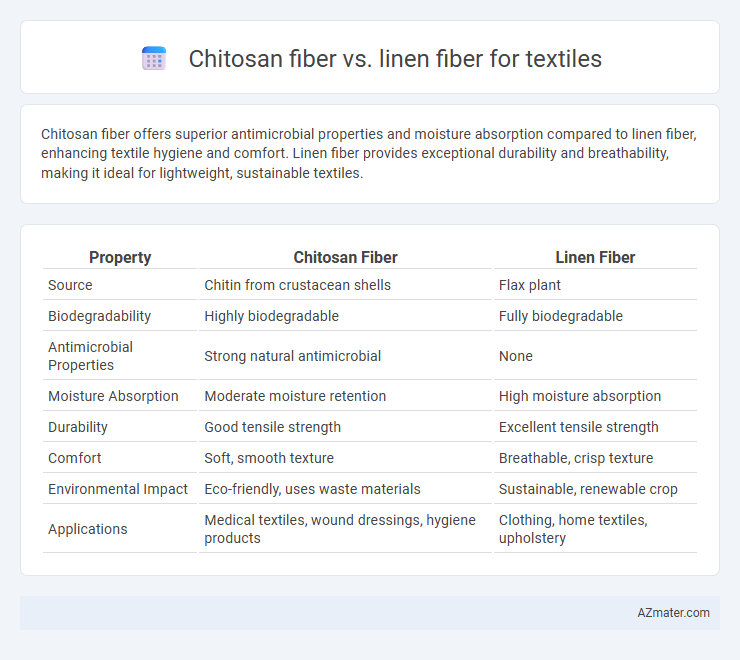Chitosan fiber offers superior antimicrobial properties and moisture absorption compared to linen fiber, enhancing textile hygiene and comfort. Linen fiber provides exceptional durability and breathability, making it ideal for lightweight, sustainable textiles.
Table of Comparison
| Property | Chitosan Fiber | Linen Fiber |
|---|---|---|
| Source | Chitin from crustacean shells | Flax plant |
| Biodegradability | Highly biodegradable | Fully biodegradable |
| Antimicrobial Properties | Strong natural antimicrobial | None |
| Moisture Absorption | Moderate moisture retention | High moisture absorption |
| Durability | Good tensile strength | Excellent tensile strength |
| Comfort | Soft, smooth texture | Breathable, crisp texture |
| Environmental Impact | Eco-friendly, uses waste materials | Sustainable, renewable crop |
| Applications | Medical textiles, wound dressings, hygiene products | Clothing, home textiles, upholstery |
Introduction to Chitosan and Linen Fibers
Chitosan fiber, derived from chitin found in crustacean shells, offers biodegradability, antimicrobial properties, and excellent moisture absorption, making it a sustainable option for advanced textiles. Linen fiber, sourced from the flax plant, is renowned for its strength, breathability, and natural luster, commonly used in durable, lightweight fabrics. Both fibers provide eco-friendly alternatives in textile manufacturing, with chitosan emphasizing functional benefits and linen excelling in traditional comfort and durability.
Origin and Production Methods
Chitosan fiber originates from chitin, a natural polysaccharide found in the exoskeletons of crustaceans like shrimp and crabs, and is produced through a deacetylation process that transforms chitin into chitosan before being spun into fibers. Linen fiber is derived from the flax plant, where the fibers are extracted through retting, drying, and scutching methods to obtain long, strong bast fibers suitable for spinning. The production of chitosan fiber involves more chemical processing compared to the predominantly mechanical and biological techniques used for producing linen fiber.
Physical Properties Comparison
Chitosan fiber exhibits superior moisture absorption and antibacterial properties compared to linen fiber, making it highly suitable for hygienic textile applications. Linen fiber offers greater tensile strength and durability, providing long-lasting fabric performance in apparel and home textiles. While chitosan fiber is more elastic and lightweight, linen fiber is known for its breathability and natural luster, enhancing wearer comfort and aesthetic appeal.
Biodegradability and Environmental Impact
Chitosan fiber exhibits excellent biodegradability due to its derivation from natural chitin, leading to rapid decomposition in soil and water environments without releasing harmful residues. Linen fiber, sourced from flax plants, is also eco-friendly, offering strong biodegradability but with a longer decomposition period compared to chitosan. The environmental impact of chitosan fiber production is generally lower, as it utilizes waste shell materials from seafood processing, while linen cultivation requires significant land and water resources, affecting sustainability metrics in textile manufacturing.
Moisture Absorption and Breathability
Chitosan fiber exhibits superior moisture absorption due to its hydrophilic amino groups, which enhance water retention and promote quick drying, making it ideal for activewear and medical textiles. Linen fiber offers excellent breathability owing to its natural cellulose structure, allowing efficient air circulation and moisture evaporation, thus providing comfort in hot climates. Both fibers contribute uniquely to textile performance, with chitosan excelling in moisture management and linen in ventilation.
Antimicrobial and Hypoallergenic Features
Chitosan fiber exhibits robust antimicrobial properties due to its inherent ability to inhibit bacterial growth, making it highly suitable for hygienic textile applications. Linen fiber, derived from flax, also offers natural hypoallergenic benefits and breathability but lacks significant antimicrobial activity compared to chitosan. The combination of chitosan's antimicrobial efficacy and linen's skin-friendly characteristics positions these fibers competitively in the development of advanced functional textiles.
Applications in the Textile Industry
Chitosan fiber offers antimicrobial properties, making it ideal for medical textiles, sportswear, and wound dressings, while linen fiber is prized for its breathability and durability in casual and luxury apparel. The biodegradability of chitosan fiber supports sustainable fashion initiatives, whereas linen's natural moisture-wicking ability enhances comfort in hot climates. Both fibers are increasingly incorporated into eco-friendly textile blends to meet consumer demand for functional and sustainable fabrics.
Durability and Maintenance
Chitosan fiber exhibits superior durability compared to linen fiber due to its natural antimicrobial properties that resist degradation and bacterial growth, extending fabric lifespan. Linen fiber, while strong and breathable, tends to weaken with repeated washing and requires careful maintenance to prevent fraying and shrinking. Maintenance of chitosan fiber is more straightforward, as it resists odor and stains, reducing the frequency of laundering and preserving fabric integrity.
Cost Analysis and Market Availability
Chitosan fiber, derived from crustacean shells, generally incurs higher production costs due to its complex extraction and processing methods compared to linen fiber, which is sourced from flax plants with well-established, cost-efficient supply chains. Linen fiber boasts widespread market availability supported by a mature global agricultural and manufacturing infrastructure, whereas chitosan fiber remains niche with limited large-scale commercial distribution. The premium pricing of chitosan fiber reflects its antimicrobial properties and biodegradability, positioning it as a specialized textile option in contrast to the more affordable and readily accessible linen fiber used for everyday applications.
Future Prospects and Innovations
Chitosan fiber, derived from the natural polysaccharide chitosan, shows promising antimicrobial properties and biodegradability, positioning it as a sustainable alternative to traditional linen fiber in textile applications. Innovations in chitosan fiber production focus on enhancing fiber strength, moisture absorption, and dye affinity to meet evolving consumer demands for eco-friendly and functional fabrics. Future prospects include integrating chitosan fibers with smart textile technologies for biomedical and sportswear markets, leveraging their biocompatibility and advanced performance characteristics.

Infographic: Chitosan fiber vs Linen fiber for Textile
 azmater.com
azmater.com